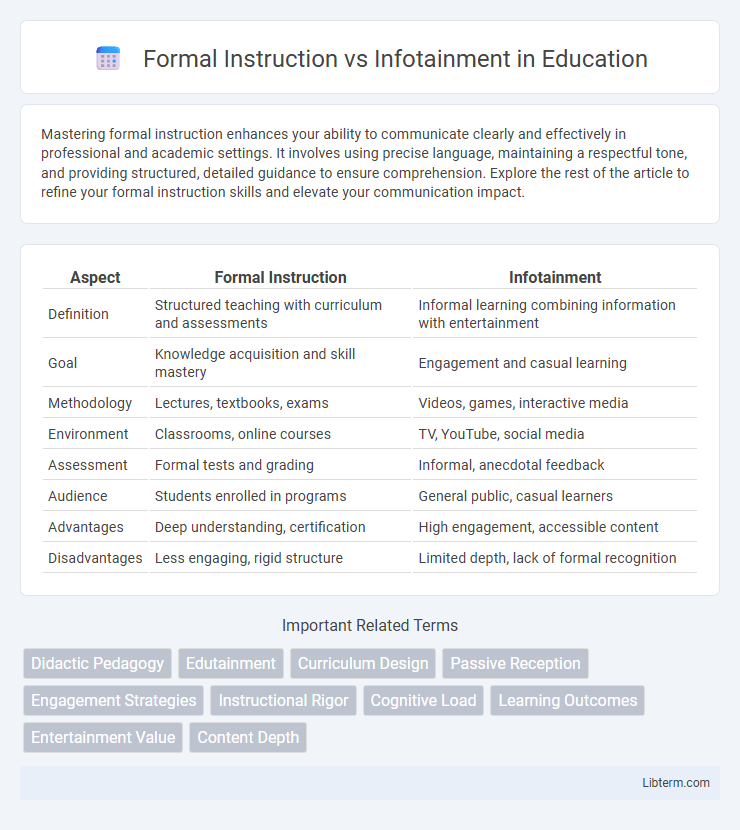Mastering formal instruction enhances your ability to communicate clearly and effectively in professional and academic settings. It involves using precise language, maintaining a respectful tone, and providing structured, detailed guidance to ensure comprehension. Explore the rest of the article to refine your formal instruction skills and elevate your communication impact.
Table of Comparison
| Aspect | Formal Instruction | Infotainment |
|---|---|---|
| Definition | Structured teaching with curriculum and assessments | Informal learning combining information with entertainment |
| Goal | Knowledge acquisition and skill mastery | Engagement and casual learning |
| Methodology | Lectures, textbooks, exams | Videos, games, interactive media |
| Environment | Classrooms, online courses | TV, YouTube, social media |
| Assessment | Formal tests and grading | Informal, anecdotal feedback |
| Audience | Students enrolled in programs | General public, casual learners |
| Advantages | Deep understanding, certification | High engagement, accessible content |
| Disadvantages | Less engaging, rigid structure | Limited depth, lack of formal recognition |
Defining Formal Instruction and Infotainment
Formal instruction is a structured educational approach characterized by standardized curricula, clear learning objectives, and assessment methods designed to measure student progress in academic settings. Infotainment combines information with entertainment, using engaging multimedia formats such as videos, games, and interactive content to capture audience attention and facilitate learning in informal contexts. Both methods seek to impart knowledge, but formal instruction emphasizes discipline and rigor, while infotainment focuses on accessibility and engagement.
Historical Evolution of Educational Approaches
Formal instruction, rooted in structured curricula and teacher-led classrooms, has evolved since ancient civilizations prioritized rote memorization and standardized testing to ensure consistent knowledge transfer. Infotainment emerged in the 20th century with the rise of television and digital media, blending entertainment with educational content to engage learners and enhance retention through interactive and multimedia formats. Modern educational approaches increasingly integrate both methods, leveraging formal instruction's rigor alongside infotainment's engagement strategies to cater to diverse learning styles and technological advancements.
Core Objectives: Learning vs Engagement
Formal instruction prioritizes structured learning objectives designed to impart specific knowledge and skills through systematic teaching methods. Infotainment emphasizes audience engagement by blending entertaining elements with informational content to capture attention and enhance retention. Balancing these approaches ensures effective education by integrating clear learning outcomes with captivating delivery.
Content Structure: Rigidity vs Flexibility
Formal instruction employs a rigid content structure with predefined modules and clear learning objectives to ensure consistent knowledge delivery. Infotainment embraces flexibility, blending educational content with engaging multimedia elements to adapt dynamically to audience interests and learning paces. This contrast influences learner engagement and retention, where structured sequences provide clarity but less adaptability, while flexible formats enhance motivation but may lack systematic progression.
Role of Technology in Shaping Delivery
Technology transforms formal instruction by enabling interactive platforms, virtual classrooms, and real-time assessments that enhance structured learning experiences. In infotainment, technology integrates multimedia elements like video, audio, and gamification to engage audiences while delivering educational content seamlessly. Both methods leverage digital tools to personalize learning paths and increase accessibility, shaping the future of education delivery.
Audience Interaction and Feedback
Formal instruction emphasizes structured audience interaction through scheduled Q&A sessions and standardized feedback forms designed to assess comprehension and retention. Infotainment leverages dynamic, real-time engagement techniques such as interactive polls, social media integration, and informal feedback channels to enhance audience participation and enjoyment. Audience feedback in infotainment settings is often immediate and adaptive, enabling content creators to tailor experiences rapidly compared to the more static, evaluative feedback loops typical of formal instruction.
Advantages of Formal Instruction
Formal instruction provides structured learning with clear objectives, ensuring comprehensive coverage of essential topics and consistent assessment of progress. It fosters discipline and critical thinking by promoting systematic study and focused practice within a curriculum designed by educational experts. This method enhances retention and mastery of complex subjects through guided feedback and standardized evaluation techniques.
Benefits of Infotainment Methods
Infotainment methods enhance learning engagement by combining educational content with entertainment elements, increasing motivation and information retention. These approaches often utilize multimedia tools such as videos, interactive games, and storytelling, which cater to diverse learning styles and improve cognitive absorption. Infotainment also promotes active participation and critical thinking, making complex concepts more accessible and enjoyable for learners.
Potential Drawbacks and Limitations
Formal instruction often suffers from rigid structures that may stifle creativity and limit engagement, leading to reduced knowledge retention. Infotainment, while engaging, risks oversimplifying complex topics, potentially causing misinformation or superficial understanding. Both methods require careful balance to ensure depth of content without sacrificing learner motivation or accuracy.
Finding the Right Balance for Effective Learning
Finding the right balance between formal instruction and infotainment involves integrating structured curriculum with engaging, multimedia content to enhance learner motivation and retention. Research shows that combining clear learning objectives with interactive elements like videos, quizzes, and storytelling increases knowledge assimilation by up to 60%. Effective learning environments prioritize meaningful context and active participation over passive consumption to maximize cognitive processing and long-term memory.
Formal Instruction Infographic

 libterm.com
libterm.com